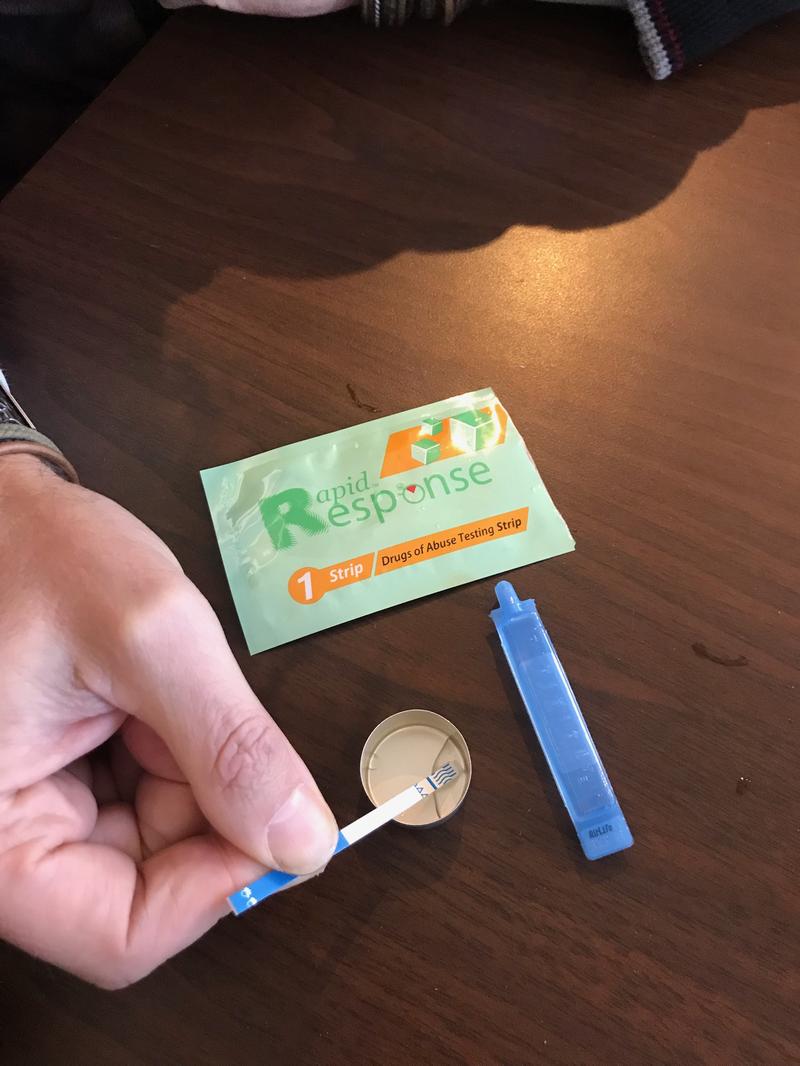Why Fentanyl Is Ending Up in More Street Drugs

( Alexandra Botti/The Takeaway )
[music]
Brian Lehrer: Brian Lehrer on WNYC. If you go out partying with drugs, you may have heard from a friend or a friend of a friend that there is a Fentanyl in cocaine problem and to be careful. That's right, Fentanyl, the synthetic opiate, that's been creeping into heroin over the past few years because it's cheaper and more addictive and it causes the majority of overdose deaths we're told, is now showing up in other street drugs. It has the potential to cause more accidental overdoses, especially because people using stimulants like cocaine might not think to carry Narcan. With me now to talk about this is Caroline Lewis, a freelance journalist who frequently contributes to Gothamist and WNYC who's been reporting on this topic. Hi Caroline. Welcome back to the show.
Caroline Lewis: Hi, thanks for having me. Good to be back.
Brian Lehrer: Why would Fentanyl be in cocaine? They have the opposite effect, right? One's a powerful opiate. The other is a stimulant.
Caroline Lewis: That's a good question. The answer is we are not totally sure at this point. As you mentioned, it frequently shows up in heroin and it's intentionally cut into heroin or even sold in lieu of heroin. There is the possibility that it's accidentally making its way into cocaine in certain situations. If someone's mixing white powders they might accidentally mix it in. Even a trace amount of Fentanyl could have a big impact on someone who has no tolerance for opioids because they don't regularly do opioids. Then it might be possible that dealers are sometimes putting it in on purpose. Again, it's cheap to make and highly addictive and maybe once it starts filling up, someone's like, "Oh, I actually liked that." I think at this point we need to do more research where we're actually interviewing people about this.
Brian Lehrer: To the question of how big a problem this is, right now, in April, I see you received data from the NYPD that indicated 8% of the city's cocaine supply now contains Fentanyl. That would be about one out of every 12 bags sold on the street, which is a lot. I think you expressed some hesitancy with this data. Can you talk it out for us?
Caroline Lewis: Absolutely. I'm glad you brought that up. I think it's important to acknowledge that we actually don't know how prevalent Fentanyl is in the cocaine supply right now, and obviously it can fluctuate. When I first started reporting this story, I was very alarmed because the city health department knows that NYPD drug testing from April, their data from April showed that 8% of the cocaine they tested from their drug seizures contained Fentanyl, but I've since learned that it's possible that April was an outlier. I'm still working to get more data from the NYPD for the months leading up to that, and after that, put it in context.
I would say based on additional research that I've done, I would speculate that if we look at it on an annual basis, the surge of cocaine laced with Fentanyl is likely less than 8%. That said, even if in April, it was an outlier. I think it shows that you never know roundabout, that might be going around. I think in general it would be great if we did more drug testing and were able to get data from sources other than law enforcement.
Brian Lehrer: Listeners, have you, or has anyone been affected by this summer's apparent increase in Fentanyl laced cocaine overdoses, call us and help us report this story at 646-435-7280. Maybe if you're a cocaine user, you've sought out Narcan, the anti-overdose antidote for the first time, or Fentanyl testing strips, what was that experience like? Do you work in healthcare, substance abuse treatment, and/or harm reduction? Have you been seeing more patients? If you do that work, who've overdosed on synthetic opioids in the past weeks or months, or years? We also want to hear from you.
If you work at nightlife, do you have Narcan on your premises or have you trained your staff on how to spot an overdose? Have you had to put that training into practice? 646-435 for those questions or anything else? 646-435-7280 or tweet @BrianLehrer. With Caroline Lewis, health journalist who contributes frequently to Gothamist and WNYC and also with us now is Sessi Kuwabara Blanchard, who is a harm reduction outreach worker at a New York City syringe exchange program and director of the Democratic Socialists of America's opioid overdose prevention program. Also a freelance journalist. Sessi, thank you for coming on with us. Hi.
Sessi Kuwabara Blanchard: Hi, Brian. It's great to be with you.
Brian Lehrer: Let me ask you about a particular incident. I see that you say you helped reverse a Coke-Fentanyl overdose at a Bushwick rave in June. Can you tell us about that experience? Was it the first time you had witnessed the effect of cocaine laced with Fentanyl?
Sessi Kuwabara Blanchard: It actually was, and I think that might speak to the rarity at this point of these overdoses or at least like the confer situation of cocaine mixed with Fentanyl, but it was at the end of May. I was walking out of the rave actually and then a huge crowd had formed. Someone was falling out. That's like the colloquial phrase for overdosing. I always carry two Narcan doses in my purse with me. That's really important too, for listeners to know, is that one of the doses of Narcan usually isn't enough, especially when Fentanyl's involved. It's always really important to bring multiple doses with you. I whipped it out and I actually had to pass it off to someone who then administered it, but it was like a tag-team situation.
Again, I think I do want to emphasize that this is a very rare occurrence or at least in term, as far as confirmed cases go and I think it is worth emphasizing. I know Caroline has mentioned this, but there's only been two reported cases or at least it's trending story right now is only based off of two rumored stories. As far as I know, none of them have actually been confirmed to involve either. Neither of the deaths have actually been attributed directly to those substances. I do think we need to be careful when we're talking about this as a trend. I think also the seizure data and as Caroline said that April may have been an outlier. I do think we need to be a bit careful when we're talking about this issue.
Brian Lehrer: Sessi, from your knowledge base as a harm reduction outreach worker, might someone who's expecting a stimulant and receives a powerful opioid instead, or in addition without expecting it be more vulnerable to overdose as far as you know and if so, why would it work that way?
Sessi Kuwabara Blanchard: Absolutely. First off when you're using a stimulant, you just aren't expecting usually-- unless you're mixing it intentionally, which is a speedball in the case of cocaine and opioid and then a gas ball as far as methamphetamine and an opioid goes. There's the first element that you're just simply not expecting it. The facts are quite different, but also on a physiological level, the stimulant either in this case, cocaine, but also methamphetamine makes your body work harder. Then you need to breathe more. You need more oxygen. Then at the same time the opioid and in this case, Fentanyl which is very potent, far more potent than heroin it's suppressing your ability to breathe and get that oxygen. Then that's how that cocktail can prove more, more fatal than otherwise.
Brian Lehrer: Caroline, did you want to add something there?
Caroline Lewis: Yes. This was actually just in response to how big of an issue this trend is. I agree that recent anecdotal reports mostly have not been confirmed. I had submitted a name of someone I heard overdosed from a suspected mixture of cocaine and Fentanyl to the medical examiner and haven't heard back yet, but in terms of data, there is data showing that overdose deaths involving cocaine and synthetic opioids have been going up in recent years, both in New York and nationally.
I think it's still somewhat unclear how much of that is the result of people intentionally doing multiple drugs either at the same time or separately, and how much of it is unsuspecting cocaine users getting psyched drugs. There is evidence that that happens. There've been clusters of-- there've been incidents where several people will go to the ER within a few hours in a small geographic area, including one incident in New York City in 2019 with Fentanyl overdoses and they tested cocaine. I think there's evidence that it happens and the question is just really how often?
Brian Lehrer: Aaliyah in Newark, you're on WNYC. Hello, Aaliyah. Thank you for calling in.
Aaliyah: Hello.
Brian Lehrer: Hi there. We got you.
Aaliyah: Hey, so I was calling, I was saying that I hear there's a lot of emphasis being placed on how there's Fentanyl in opioids and people in nightlife and things like that. I'm also noticing that there's been a spike in overdoses in teenagers that are 17, 18, 19 years old in their early 20s and all college campuses, because they're taking these pills, these pharmaceutical pills that are being made and formed now, and those are made with Fentanyl and people are literally taking one pill to have a good time and they're dying and they're 17 and 18 years old.
Brian Lehrer: You told our screener anti-anxiety meds, common meds like Xanax laced with Fentanyl. Are you seeing that Sessi? Any idea about that?
Sessi Kuwabara Blanchard: The issue of press pills it's huge, and that includes Xanax and other pills like, Oxy, and other presumably pharmaceutical opioid pills. Correct.
Brian Lehrer: Aaliyah, thank you very much for pointing that out. Another thing to be careful about. Andy in Bushwick, you're on WNYC. Thank you for calling in.
Andy: Hey, how's it going? I just had to piggyback on this discussion. I am a DJ in the Brooklyn scene, and I know that we deal a lot with GHB as a substance in New York. I understand that a lot of EMTs are not always trained in how to deal with this. I'm just adding this to the discussion because it seems like there's a lot of misinformation about what actually is going on in-- sorry, I'm a little nervous. It seems a lot of misinformation about what types of substances are actually being used. I'm curious if you guys could add a little bit to the discussion.
Brian Lehrer: Caroline, anything on that?
Caroline Lewis: I'm not sure actually about GHB and whether that's being laced. I think also there's a lot-- I actually would be interested in what Sessi has to say because I think that often things are captured in anecdotal report and people just being involved in the scene that wouldn't necessarily be captured in data that I've been looking at.
Brian Lehrer: Sessi, go ahead.
Sessi Kuwabara Blanchard: Definitely. GHB is definitely a huge issue-- I mean, not an issue as in a problem, but I think, the health consequences and the consequences, but people aren't fully informed about, how to use safely is definitely a big issue, particularly within queer and trans party scenes and culture. There's no evidence to suggest that GHB or GBL is being laced or tainted with Fentanyl but a lot of it comes down to people simply not being informed about exactly what the drug they're using even is because there's quite a big difference between GHB, versus GBL, which is a precursor drug to GHB.
GBL is far more potent and it crosses the blood-brain barrier much faster. You feel the effects, more quickly and it hits harder, and it moves along faster. There's simply that issue and we know while there's not a Narcan antidote to GHB overdoses, we know that the structural solution to this is a safe supply, meaning, decriminalizing the supply chain and setting up some legal regime, such that people are able to access pharmaceutical grade, drugs that have been tested for quality, and there's full information about what consumers are actually getting.
Brian Lehrer: I was going to ask you that at the end of the segment, but I'll ask you now. People who go into marijuana dispensary's in legal states, we'll see pretty precise breakdowns of ingredients that are in different cannabis products. There are state regulatory agencies and testing required to control things like that. Do you think, as someone who works in harm reduction that there would be less harm from opioids or any other potentially dangerous drug, if what we think of as illegal a street drug right now was treated in the same way?
Sessi Kuwabara Blanchard: Absolutely. It's not even a question and it's not even a matter of my own personal opinion. We have so much data about this specifically when it comes to pharmaceutical-grade heroin. There are decades of research about heroin-assisted treatment. That's in Switzerland, that's in the UK, that's in Canada and we know that, overdoses go down and then overall, beyond just saving people and preventing deaths, we want to make sure people are actually being able to live fulfilling stable lives.
That's what we see in the data is that people are actually stabilized when they know what's exactly in their drugs, where they can get it routinely, the price is stable. It's not being interrupted, whenever, there's a big drug bust going on. We know that it improves consumers lives and it's a matter of reframing the conversation entirely, around bodily self-determination, and really empowering people to make make their own decisions, and giving them all the resources that they need to be taking care of themselves.
Right now it really, the paradigm is not that. It's very much about the state giving little tools out, basically giving breadcrumbs to the problems that they've created. I think that's a really important part of all of this is that the problem isn't Fentanyl itself. 10 years from now if we still have a criminalized drug supply, it's going to be something different, and the problem really is prohibition itself and the entire drug war we've seen, in data through research, that its effect is that it destabilizes the drug supply chain and it makes the supply completely unpredictable and ever more potent. That theory is called the iron law of prohibition. There's a lot of research to support that.
Brian Lehrer: We're almost out of time, but I know you have both spoken about the changing demographics of who's using these particular drugs. Caroline recent reporting on cocaine laced with Fentanyl has focused on the rave culture, mostly concentrated in Northern Brooklyn and Southern Queens, but you reported in June that 42% of cocaine involved overdoses in New York City occurred in the Bronx, followed by 25% in Manhattan, whereas only 17 and 14% of these deaths respectively happened in Brooklyn and Queens. What does this data indicate to you in our last minute?
Caroline Lewis: I just want to clarify also that that's 42% of the overdose deaths involving cocaine and Fentanyl without heroin in 2019 took place in the Bronx. Literally, the exact problem we're talking about is not concentrated in these, what's seen as this wealthy, white party culture, even though that's the image that cocaine has as a drug. I think that it just speaks to where we need to direct resources and who really is most at risk from these drugs.
Brian Lehrer: Do you want to add anything to that as a final thought, Sessi?
Sessi Kuwabara Blanchard: Definitely. I think just circling back really quickly to my original comment about being wary of this as a trend, what I meant by that was specifically this as a trend among like hipster, professionalized white wealthier class. We have to be aware of that as a trend because for decades now, Black and brown communities have been suffering. From the data, and with the concentration in the Bronx, it very much is an issue that's been longstanding and we have to be careful about thinking about this as a trend based off of claims related to the death of two people in a relatively affluent community. We have to be thinking about this long-term and actually giving the resources where they're due.
Brian Lehrer: Sessi Kuwabara Blanchard is a-- sorry, I had that in front of me and now it popped out, there it is, harm reduction outreach worker at a New York City syringe exchange program, program director of the Democratic Socialists of America's opioid overdose prevention program and a freelance journalist. Caroline Lewis is a health reporter who contributes frequently to WNYC and Gothamist. Thank you both so much for joining us.
Caroline Lewis: Thanks for having us.
Sessi Kuwabara Blanchard: Thank you.
Copyright © 2021 New York Public Radio. All rights reserved. Visit our website terms of use at www.wnyc.org for further information.
New York Public Radio transcripts are created on a rush deadline, often by contractors. This text may not be in its final form and may be updated or revised in the future. Accuracy and availability may vary. The authoritative record of New York Public Radio’s programming is the audio record.

